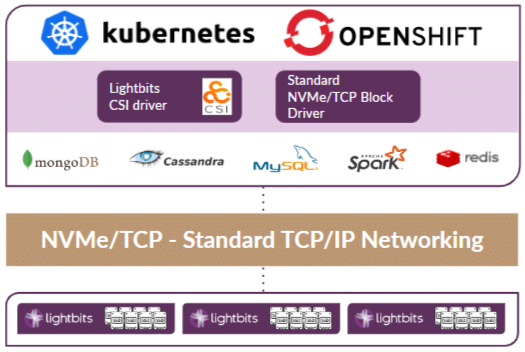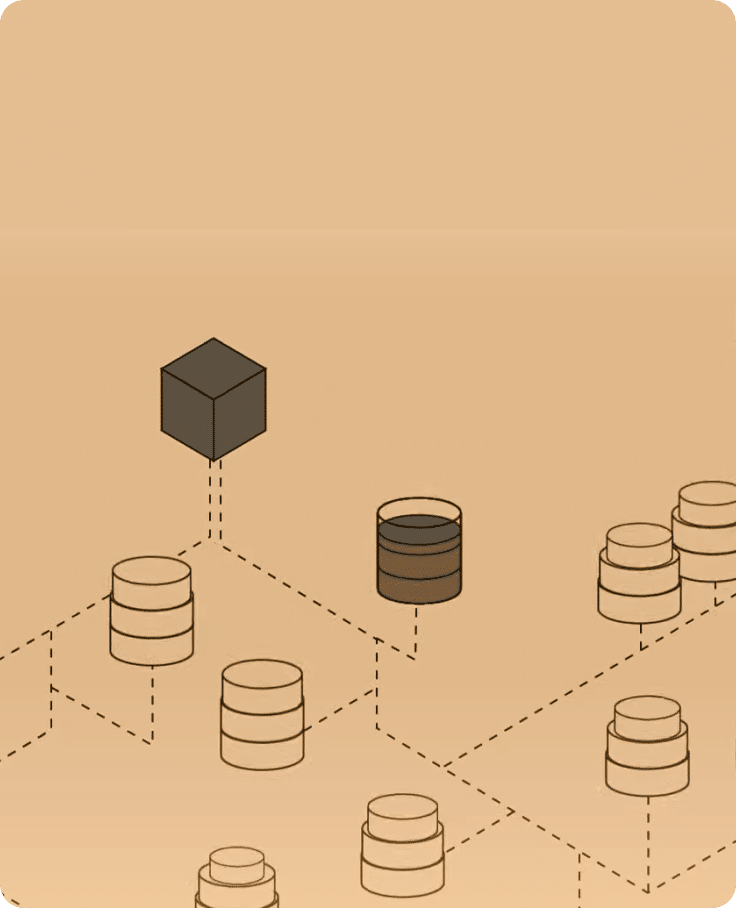Accelerate Stateful Applications with High-Performance, Disaggregated Persistent Storage for Kubernetes
Lightbits integrates seamlessly with Kubernetes and OpenShift Virtualization via our CSI plugin allowing you to easily provision and manage high-performance persistent storage for your VMs, offering the best price/performance block storage for modern application workloads at scale.
Only Lightbits software-defined storage delivers the performance of Local Persistent Volumes while retaining pod autonomy and freedom from server physicality, offering the high performance and low latency benefits of local NVMe SSDs, without compromising container portability.
One Lightbits cluster supports hundreds of Kubernetes clusters—say goodbye to complex storage management.
5 Reasons Why Lightbits is Ideal for Kubernetes
Unmatched Kubernetes Block Storage Performance
Lightbits storage software enables you to effortlessly create hundreds of new PVCs at scale without compromising IOPS or increasing latency for your running applications.
Peak Kubernetes Storage Performance for Every PVC
Lightbits ensures unmatched IOPS and ultra-low latency, delivering industry-leading performance at scale even when demand surges and the volume of PVCs grows exponentially.
Effortless Live Migration with KubeVirt
With Lightbits’ integrated CSI driver, live migration with KubeVirt is seamless and powerful, ensuring smooth migrations and effortlessly handling VMs with multiple PVCs.
Seamless Multi-Tenancy and Encryption
Lightbits delivers robust multi-tenancy and encryption eliminating complexity so you can focus on applications while maintaining optimal security and scalability.
Kubernetes Block Storage Scalability, Resiliency and Cost Effectiveness
Lightbits’ software-defined, disaggregated architecture enables independent scaling of compute and storage, offering unparalleled flexibility to meet evolving workloads and business needs. High availability is ensured through seamless storage server failover, safeguarding business continuity even during hardware failures. By leveraging standard Ethernet networks and NVMe/TCP, Lightbits reduces infrastructure costs while extending SSD lifespans with Intelligent Flash Management. With Lightbits, you can achieve the perfect balance of performance, reliability, and cost-effectiveness, redefining what’s possible in modern storage environments.
Seamless Integration with Kubernetes and OpenShift Environments
Lightbits optimizes for cost-efficiency, performance, scalability, and reliability across platforms.
✔ CSI driver for simple orchestration
✔ High performance to support thousands of applications
✔ Consistent low latency to support cloud native workloads
✔ Highly available persistent volumes
✔ No changes to your TCP/IP network with no proprietary drivers on Kubernetes servers
✔ Block storage with RWO or RWX capabilities
✔ End-to-end encryption
✔ Built-in Snapshots and Clones

Customer Story
No other storage solution had the same price-performance and tight integration into Kubernetes with the achievable low latency as Lightbits.”
— Stefan Majer, CTO at metalstack.cloud
Customer Story
Lightbits Powers 2M+ Kubernetes CPU Cores for One of the World’s Largest eCommerce Platforms
KUBERNETES STORAGE CHALLENGES
KUBERNETES STORAGE MANAGEMENT
KUBERNETES STORAGE faq
KUBERNETES STORAGE CHALLENGES
Lack of Built-in Persistence
Containers are designed to be lightweight, portable, and stateless, which means that they typically do not have built-in mechanisms for persistent data storage. As a result, any data stored within a container is ephemeral and is lost when the container is shut down or restarted. This lack of built-in persistence can pose challenges for applications that require long-term data storage or stateful operations, such as databases. Without persistent storage, organizations may struggle to maintain data integrity, continuity of operations, and compliance with regulatory requirements.
Data Management Issues in Container Clusters
Applications are often deployed as microservices across multiple containers or pods within a cluster which can lead to data fragmentation, duplication, and inconsistency. Managing data across container clusters becomes increasingly complex as the number of containers and services grows, making it difficult to track data dependencies, ensure data consistency, and implement data governance policies. Architecting Kubernetes storage as a cluster with a unified management interface can help eliminate operational inefficiencies.
Performance Considerations
Containers are known for their efficiency and scalability, but they can also introduce performance overhead, especially when it comes to storage operations. Implement the wrong storage and your Kubernetes environment may experience latency, bottlenecks, and resource contention, leading to poor application performance and user experience. Storage performance considerations become even more critical in containerized environments with high-throughput or latency-sensitive workloads, such as real-time analytics or transaction processing. Persistent storage for Kubernetes from Lightbits delivers consistent high-performance, so that you can scale your applications effectively and meet your SLAs.

KUBERNETES STORAGE MANAGEMENT
Persistent storage is essential for unlocking the full potential of Kubernetes, enabling organizations to run a wide range of workloads, including stateful applications, with confidence and efficiency. Many applications require persistent data storage to maintain their state across multiple instances, updates, failures, or restarts. Examples include databases, whereby persistent storage enables these stateful applications to be managed within container orchestration platforms like Kubernetes, allowing organizations to modernize their infrastructure without sacrificing functionality.
KUBERNETES STORAGE faq
What is the Difference Between Persistent and Non-Persistent Storage?
Persistent storage retains data beyond the lifespan of the container itself ensuring that important information is not lost and can be accessed by applications as needed. While non-persistent storage loses data when the associated process or instance is shut down or terminated.
What is the Function of Persistent Storage?
Persistent storage for Kubernetes is essential for running stateful applications and enabling data persistence in containerized environments, allowing Kubernetes to support a broader range of workloads, including those with stringent data storage requirements.
